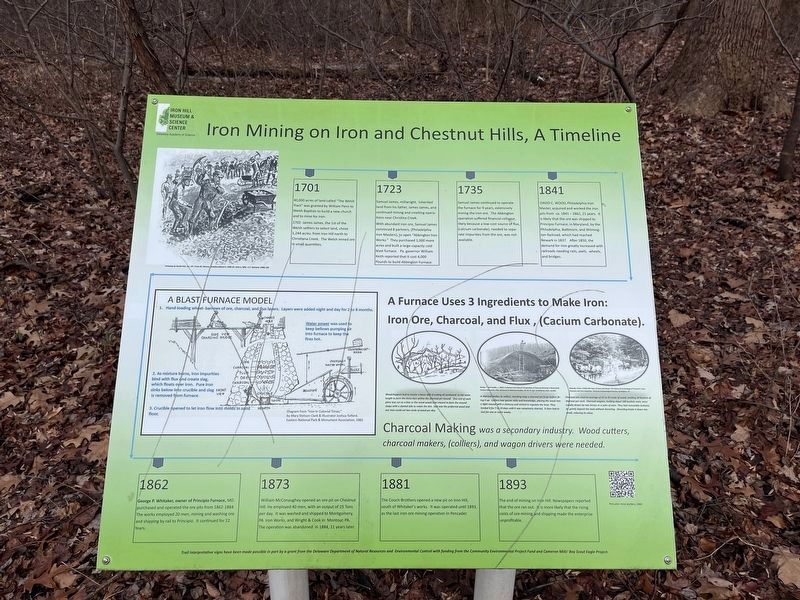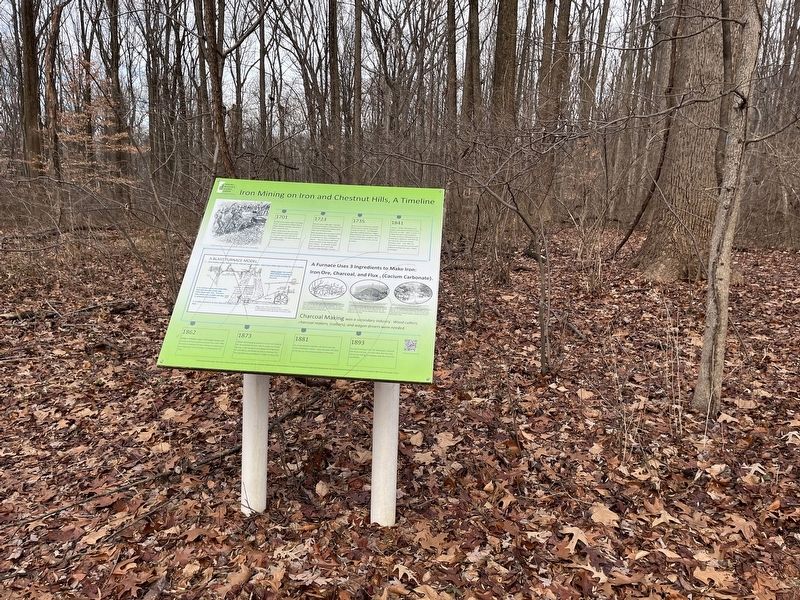Iron Hill Park near Newark in New Castle County, Delaware — The American Northeast (Mid-Atlantic)
Iron Mining on Iron and Chestnut Hills, A Timeline
Iron Hill Museum & Science Center
— Delaware Academy of Science —

Photographed By Devry Becker Jones (CC0), December 30, 2023
1. Iron Mining on Iron and Chestnut Hills, A Timeline Marker
Unfortunately, the marker appears to have experienced damage.
1701
40,000 acres of land called "The Welsh Tract" was granted by William Penn to Welsh Baptists to build a new church and to mine for iron.
1702- James James, the 1st of the Welsh settlers to select land, chose 1,244 acres: from Iron Hill north to Christiana Creek. The Welsh mined or in small quantities.
1723
Samuel James, millwright, inherited land from his father, James James, and continued mining and smelting operations near Christina Creek.
With abundant iron ore, Samuel James convinced 8 partners, (Philadelphia Iron Masters), to open "Abbington Iron Works." They purchased 1,000 more acres and built a large-capacity cold blast furnace. Pa. governor William Keith reported that it cost 4,000 Pounds to build Abbington Furnace.
1735
Samuel James continued to operate the furnace for 9 years, extensively mining the iron ore. The Abbington operation suffered financial collapse, likely because a low-cost source of flux, (calcium carbonate), needed to separate impurities from the ore, was not available.
1841
David C. Wood, Philadelphia Iron Master, acquired and worked the iron pits from ca. 1841 - 1862, 21 years. It is likely that the ore was shipped to Principio Furnace, in Maryland, by the Philadelphia, Baltimore, and Wilmington Railroad, which had reached Newark in 1837. After 1850, the demand for iron greatly increased with railroads needing rails, axels, wheels, and bridges.
1862
George P. Whitaker, owner of Principio Furnace, MD. purchased and operated the ore pits from 1862-1884. The works employed 20 men, mining and washing ore and shipping by rail to Principio. It continued for 22 Years.
1873
William McConaughey opened an ore pit on Chestnut Hill. He employed 40 men, with an output of 25 Tons per day. It was washed and shipped to Montgomery, PA Iron Works, and Wright & Cook in Montour, PA. The operation was abandoned in 1884, 11 years later.
1881
The Cooch Brothers opened a new pit on Iron Hill, south of Whitaker's works. It was operated until 1893, as the last iron ore mining operation in Pencader.
1893
The end of mining on Iron Hill. Newspapers reported that the ore ran out. It is more likely that the rising costs of ore mining and shipping made the enterprise unprofitable.
A Furnace Uses 3 Ingredients to Make Iron:
Iron Ore, Charcoal, and Flux, (Calcium Carbonate).
Woodchoppers had to master a basic skill of cutting all cordwood to the same length to form the three tiers within the charcoal pit mound. One end of each piece was cut on a bias so the wood

Photographed By Devry Becker Jones (CC0), December 30, 2023
2. Iron Mining on Iron and Chestnut Hills, A Timeline Marker
A charcoal maker, (a collier), standing atop a charcoal pit forge before firing it up. Colliers had special skills and knowledge, placing the wood into a tight mound with a chimney and vented to regulate the heat. They tended it for 7 to 10 days until it was completely charred. It then had to cool for one or more weeks.
Charcoal pits used an average of 25 to 35 cords of wood, yielding 30 bushels of charcoal per cord. Charcoal wagons, holding about 100 bushels each, were usually drawn by two horses or a yoke of oxen. They had removable bottoms to gently deposit the load without shoveling. Shoveling broke it down too small, reducing its value.
Charcoal Making was a secondary industry. Wood cutters, charcoal makers, (colliers), and wagon drivers were needed.
[Caption:]
A Blast Furnace Model
1. Hand-loading wheel- barrows of ore, charcoal, and flux layers. Layers were added night and day for 2 to 8 months.
2. As mixture burns, iron impurities bind with flux and create slag, which floats over iron. Pure iron sinks below into crucible and slag is removed from furnace.
3. Crucible opened to let iron flow into molds in sand floor.
Water power was used to keep bellows pumping air into furnace to keep the fires hot.
Diagram from "Iron in Colonial Times," by Mary Stetson Clark & Illustrator Joshua Tolford. Eastern National Park & Monument Association, 1981
Erected by Delaware Academy of Science.
Topics. This historical marker is listed in these topic lists: Colonial Era • Industry & Commerce • Natural Resources • Settlements & Settlers. A significant historical year for this entry is 1701.
Location. 39° 37.908′ N, 75° 45.513′ W. Marker has been reported damaged. Marker is near Newark, Delaware, in New Castle County. It is in Iron Hill Park. Marker is on South Old Baltimore Pike east of Whittaker Road, on the right when traveling west. The marker is on the grounds of the Iron Hill School Museum as part of the African American History Trail. Touch for map. Marker is at or near this postal address: 1355 S Old Baltimore Pike, Newark DE 19702, United States of America. Touch for directions.
Other nearby markers. At least 8 other markers are within walking distance of this location. The Civil War 1861 - 1865 (within shouting distance of this marker); Education for ALL, Past and Present: Iron Hill School, No. 112C / Iron Hill School #112C (within shouting distance of this marker); What is the mound behind this sign? (within shouting distance of this marker); The Iron Hill Community: Free Black Landowners (within shouting distance of this marker); Ninety Years Recording the Black Population of Pencader Hundred: The U.S. Census (within shouting distance of this marker); Historic Roads of Newark, Delaware / Petrified Log from Central Delaware (within shouting distance of this marker); Iron Hill School #112-C (about 300 feet away, measured in a direct line); Site of the First Iron Hill School (about 300 feet away). Touch for a list and map of all markers in Newark.
Credits. This page was last revised on December 31, 2023. It was originally submitted on December 30, 2023, by Devry Becker Jones of Washington, District of Columbia. This page has been viewed 60 times since then and 27 times this year. Photos: 1, 2. submitted on December 30, 2023, by Devry Becker Jones of Washington, District of Columbia.